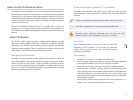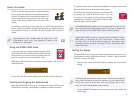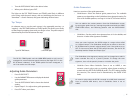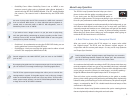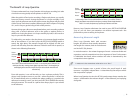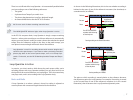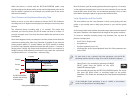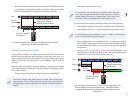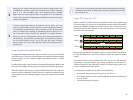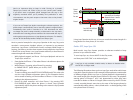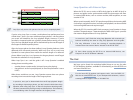
5
Guide:Play Count—When Guide:Play Count is set to 1MEAS, a one-
measure count-in plays prior to playback when phrase playback is
started with the REC/PLAY/OVERDUB pedal. (The OFF setting disables
the count-in.) The count-in level is determined by the GUIDE LEVEL
knob.
No count-in plays when the RC-50 is started via a MIDI clock command
from an external MIDI device, or when individual phrase playback is
started with an external pedal or MIDI CC #80 assignment, even if
Guide:Play Count is set to 1MEAS.
If you wish to have a longer count-in—or you just want to play along
with the guide before committing to phrase recording—set Rec Count
and Play Count to OFF, and use GUIDE START/STOP to start the guide
sound prior to phrase recording.
Guide:Level—As an alternative to using the GUIDE LEVEL knob, you can
set the guide level (or turn the guide off) here.
Guide:Output—Here you can assign the guide sound to either or both
of the RC-50’s output pairs (MAIN and/or SUB).
Sounds assigned to the MAIN OUTPUT jacks are sent to the PHONES
jack as well.
By assigning the guide sound to a separate output pair from the phrases,
you can isolate it for onstage monitoring or recording applications.
The RC-50 has system output settings that allow you to override the
settings made in a patch. If the guide output is set in this way, changes
made on the Guide:Output screen won’t have any effect. To learn more
about system output settings, see the RC-50 Workshop booklet Patches
or Page 69 in the RC-50 Owner’s Manual.
•
•
•
About Loop Quantize
The RC-50’s Loop Quantize function helps you close a
phrase in time with the guide or another phrase, even
if you don’t press the REC/PLAY/OVERDUB pedal at
exactly the right moment. This keeps everything in sync and allows you to
focus on your performance rather than precision pedal-pressing.
Loop Quantize is designed to work automatically in the background, so you
don’t have to think about it much when it’s on. In most cases, you’ll find it
extremely natural and intuitive to use. A little later, we’ll get into the details
of how Loop Quantize works in a variety of phrase-recording scenarios.
Before that, let’s discuss how it helps you, and investigate what’s going on
under the RC-50’s hood when it’s on. But first...
...A Brief Detour into the Conceptual World
After you record a phrase, the RC-50 assigns it a tempo value called
the “original tempo.” The RC-50 uses the phrases’ original tempos—in
conjunction with the current patch tempo—to carry out its Loop Quantize
and Tempo Sync functions.
Patch tempos, phrases’ original tempos, and Tempo Sync are covered in
the RC-50 Workshop booklet Tempos and Tempo Sync. We recommend
you check it out if you want to learn more about them.
As containers that hold audio recordings, the RC-50’s phrases don’t have any
musical properties of their own, per se; any musicality they have is inherited
from the audio with which you fill them. Since we don’t actually know what
you’re going to record in a phrase, its actual tempo—musically speaking—
might be different than the original tempo the RC-50 assigns to it.
That said, when you’re recording while listening to the guide or another
phrase, you’re usually going to be performing something that’s rhythmically
related to what you’re listening to. In this circumstance, the phrase’s original
tempo—as assigned by the RC-50—should match the actual tempo of the
audio that’s in the phrase.
Our discussion about Loop Quantize assumes that you’re creating phrases
that are rhythmically related to the guide and each other.




